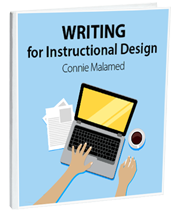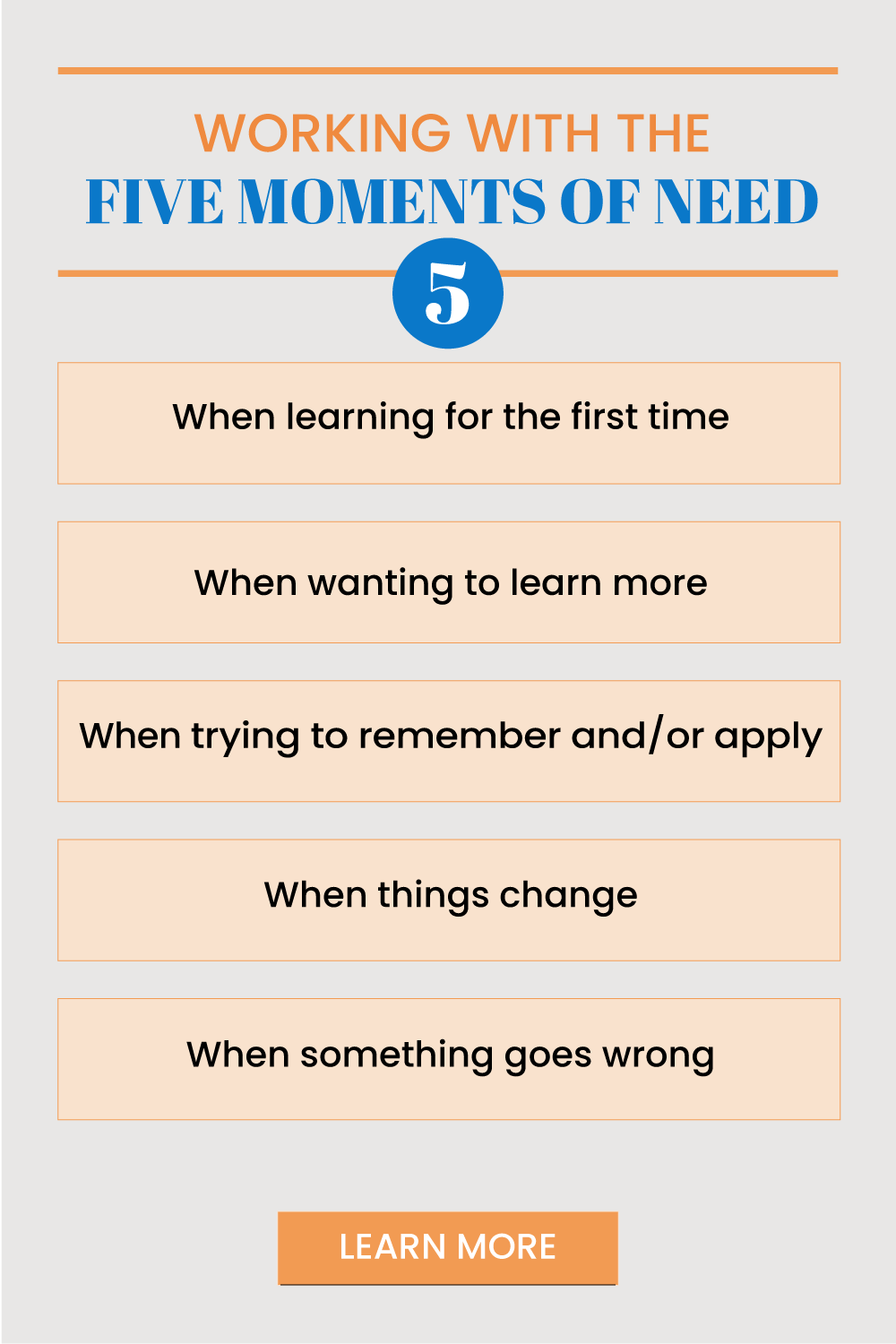
Are you able to convince clients, stakeholders and SMEs to cut back on the massive content they load into a course? Do you need to decide whether to include performance support rather than what seems like an entire curriculum? You may find your answer in the Five Moments of Need framework developed by Conrad Gottfredson with contributions from Bob Mosher. It delineates five specific conditions or situations in which people require instruction or assistance.
When I first came across this approach, a light bulb turned on. This was exactly what I’d been looking for to cut through the content tug of war I often play. I’ve tried convincing course stakeholders that less content provides more learning. I’ve explained the limitations of working memory and cognitive load. All of this has brought limited success. But nearly everyone can relate to a moment of need.
The Needs
Mosher and Gottfredson have distilled the needs surrounding performance improvement into five distinct categories. The first two in the list typically benefit from formal, structured learning, particularly for novices. The final three typically benefit from performance support, including just-in-time information, micro-instruction, conversation and other less formal learning approaches.
The five needs that occur in the flow of work are:
1. New: Learning something for the first time
2. More: Expanding upon previous knowledge
3. Apply: Acting upon learned knowledge and skills
4. Change: Adapting knowledge to new trends
5. Solve: Solving new problems when they arise
Fitting into Your World
So how can you fit this model into your world? After you’ve done some research and analysis to understand your audience and what they need to perform, you should be able to identify which tasks and content correspond to a specific moment of need. Focus on the person’s needs rather than the content. In fact, this should allow you to streamline the content. Include the skills and knowledge that involve learning for the first time or learning more (needs #1 and #2). And support tasks and knowledge that correspond to needs #3, #4, and #5 through other approaches. See How to Get Started with Performance Support.
For example, in an orientation course for new employees, you may want to present an explanation of the company’s complex investment and health benefit options in a formal course. An audience of new employees would be learning this for the first time (need #1). On the other hand, it might be difficult to remember this complex information when it’s time to invest or choose health options, so a simple support web page through the Human Resources Department would be appropriate for fulfilling the need to remember and apply what they learned (need #3).
Using for Push Back
Once you get the hang of it, it’s quite easy to use the Five Moments of Need to steer SMEs and stakeholders in the right direction. For example, I recently attended a meeting where I distributed the Five Moments of Need list to each person present.
As we discussed the various elements of the course content, I would simply ask the group what type of need the content fulfilled. If it turned out to be a need for applying, changing or solving, we agreed to present the content in a performance support context. In this particular organization, the easiest approach was to distribute support information in .pdf documents as attachments in an eLearning course. For other organizations it might make sense to create a Wiki. See the table below for other possibilities.
Lining Up Needs and Approach
There are many approaches for providing instruction or performance support that correspond to each moment of need. Here are some suggestions below for starters.
| Moment of Need | Possible Approaches |
|---|---|
| New: Learning something for the first time | Microlearning, eLearning, classroom or virtual classroom, self-study |
| More: Expanding upon previous knowledge | Microlearning, eLearning, classroom or virtual classroom, self-study, content curation |
| Apply: Acting upon learned knowledge and skills | Practice, scenarios, simulations, eLearning |
| Change: Adapting knowledge to new trends | Job aid (online or offline), documentation, mobile performance support, microblogging, wikis, direct messaging |
| Solve: Solving new problems when they arise | Help Desk, FAQ, performance support, forums, microblogging, wikis, chat, forums, blogs |
As always, use any model as a guide only and make your decisions on what’s appropriate for the specific audience and learning environment for which you’re designing.
RESOURCES:
- Building Courses from Curated Content
- The 5 Moments of Need Explained in 5 Minutes
- Workflow Learning
- Innovative Performance Support by Conrad Gottfredson and Bob Mosher



Leave a Reply